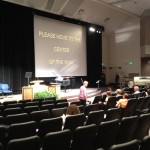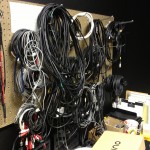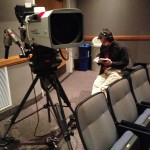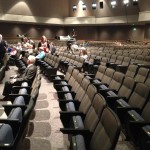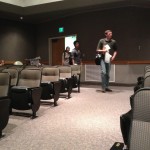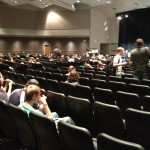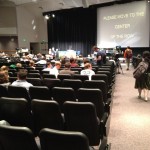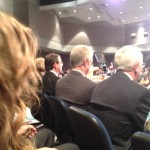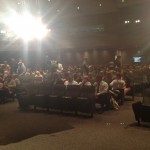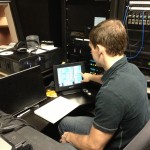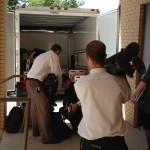Each Tuesday morning, at least 100 lights, 20-plus employees, five cameras, three teleprompters, plenty of chairs and countless hours of preparation all come together so viewers can hear just one speaker.
Since BYU opened its doors in 1875, weekly devotionals, forums and other assemblies have been something that has set the university apart. Each week, thousands of students gather in the Marriott Center and other locations to listen to the speaker without taking a second thought about all the work that goes into making each event possible.
Preparation for devotionals and forums often begins months beforehand, with the speaker selection process.
“Devotional speakers representing the campus community are chosen by the BYU Administration, which includes the deans of every college,” explained Carri Jenkins, director of University Communications. “Members of the campus community are welcome to suggest a devotional speaker. General Authorities and general officers are scheduled by the Church.”
Forum speakers are chosen in a similar way. The campus community can nominate a forum speaker by submitting a form to the Forum Committee, which ultimately makes the decision. However, choosing a speaker is only the first step.
As the speaking date approaches, BYU Broadcasting and the AV production team work together to make it possible for everyone to enjoy the speaker’s message. AV production’s role is to manage all the technical aspects of the event inside the venue where the speaker will be. BYU Broadcasting then takes that message to viewers around campus and the world.
Those assigned to the teleprompters receive a script of the speech the day before the event, and they go through and load those scripts into the teleprompter software.
“They have to go through that talk word for word, making sure that everything is spelled correctly and in there correctly,” said Ray Lines, director of the AV production team. “Then what happens, typically, is there will be changes at the last second. The speaker will do a rehearsal and the speaker will make changes … the operator has to make those changes and make sure the script is exactly how they want it.”
The day of the event, preparation starts around 8 a.m. The camera operators, audio technicians, operations manager and engineers all load their equipment into the truck at the BYU Broadcasting Building and then go to the Joseph Smith Building or Marriott Center, depending on what time of year it is. They park the truck in the back and start the unloading process.
The camera operators begin assembling their cameras, while others prepare their equipment. Depending on what kind of musical number will be performed that day, the audio crew will set up microphones in certain locations. Lighting and sound details need to be adjusted depending on the type of musical number that day. Since a choir would need a different sound and lighting setup than would a soloist, the crew makes sure everything is set to the correct specifications.
Once cameras are set, engineers will begin checking to make sure that cameras are receiving the proper feed, and the lighting is checked to ensure that the video will get the best picture quality. After setup is complete, there are a few hours scheduled in to make sure there is time for last-minute tweaks.
Eric Martino, a BYU Broadcasting cameraman, explained why scheduling extra time is important.
“We can set up in like an hour, but we are there for three, just in case something goes wrong,” Martino said. “Sometimes (it goes wrong) and it takes all three hours, and sometimes it doesn’t and so we’re lucky.”
Martino relayed one story of how the fiber optic cable, which allows the central control unit to access the camera, was dirty and they were not getting the right signal to the camera. The engineers had to clean the cable and make sure everything was working properly before the devotional in order to have a successful show.
“We do all that to make sure everything is good and so we can make the necessary changes,” Martino said.
By the end of setup, the performers will have shown up to rehearse their musical number. The technical director has previously looked at the music and determined what shots will look best for the number. He gives the camera operators and others a “shot sheet,” which tells them what shots will need to be taken at what time. As rehearsal goes on, camera operators determine what angles they need and adjust lighting based on where the performers will be standing.
Then, finally, it’s show time. The crowd fills the venue, camera shots are called, teleprompters roll, lights dim and the speaker stands to give his or her message while audience members listen intently.
From surveying BYU graduates, the administration found the number-one act that had affected their spiritual development at BYU was almost always devotional attendance. President Cecil O. Samuelson has reminded students that “a large part of what constitutes the unique BYU experience is found in these gatherings where the Spirit has been invited and where we have the opportunity to discuss and consider things of ultimate worth and importance that are not afforded to the academic community on almost any other campus.”

